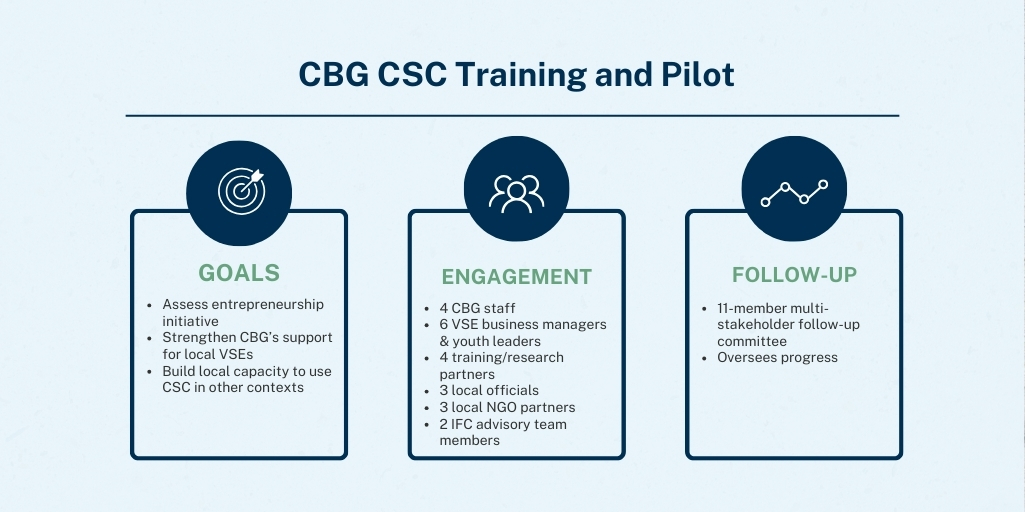
Compagnie des Bauxites de Guinée (CBG), Mining, Guinea
In Guinea, CSC opened doors for youth entrepreneurship.
 Photo by IFC
Photo by IFC
Opening doors for young entrepreneurs in Guinea
In 2010, mining company Compagnie des Bauxites de Guinée (CBG) launched an economic development initiative designed to build the local supply chain and support the creation of jobs for youth including women. The idea was to give local, youth and women-led very small enterprises (VSEs) access to affordable finance through a revolving loan facility, so they could take advantage of opportunities to provide goods and services to mining companies in Guinea’s Boké region. The initial project resulted in the creation of 14 new VSEs.
Still, in a region where relations between local communities and mining companies have not always been harmonious and incidents of social unrest and vandalism have occurred, issues remained. The VSE managers who participated in the program felt that they were not benefiting as much as they could be from the mining boom. They expressed interest in additional support to enhance their competitiveness.
The company decided to deploy the CSC methodology so they could work with the VSE managers and their teams on ways to improve the entrepreneurship initiative.

Preparing for the first CSC engagement
As the first step, CBG staff and community representatives received classroom training on the step-by-step implementation of the CSC process. Then, they practiced their new knowledge and skills by implementing a CSC engagement to assess CBG’s local entrepreneurship program.
During this engagement, CBG staff and the youth MSE representatives generated assessment criteria to measure the program’s performance. Next, they scored the program’s performance against these criteria, describing strengths and weaknesses of the program and proposing actions for improvement. In the subsequent step, company and youth representatives agreed on the joint action plan for improvement and a multi-stakeholder follow-up committee was created to follow implementation.
Results and outcomes
In the year following the CSC training and pilot, many of the agreed actions for improvement were implemented. Each step of the CSC process enhanced mutual understanding—from information-sharing and self-reflection to active listening, constructive dialogue and democratic decision making—with the follow-up committee proving an effective mechanism for ongoing and constructive dialogue.
The experience has helped strengthen relations with young community members, local officials and NGOs alike—a significant win, given the difficult mining company-community relations historically existing in the region.
Insights and lessons
The experience affirmed the relevance and versatility of the CSC tool, participants said. In particular, they noted its simplicity and effectiveness in accomplishing the identified goals—and its usefulness in a variety of situations. They also said that the basic communication, facilitation, conflict management, and persuasion skills learned as part of CSC training course will be helpful in other aspects of their professional and personal lives. Several other insights emerged from the CBG training and pilot, including:
- Providing daily ice breakers, energizers, and interactive exercises such as role plays helps create a friendly learning environment, puts participants at ease, and promotes positive relations. The degree of comfort, familiarity, and congeniality increased steadily as the process continued.
- Having the continual participation of the company’s community relations team enhances the quality of discussion and the accuracy of information exchanged. Their presence also further demonstrated the company’s commitment to engaging in such processes.
- Gaining company and community buy-in and willingness to actively and honestly engage is at the root of a successful CSC process. For example, on the first day of the CBG CSC training, two CGB managers frankly discussed the challenges faced by the company in designing and implementing the program—information that the youth VSE managers had not previously known, but which they said provided important context. In addition, all parties indicated a willingness to sustain dialogue through the multi-stakeholder follow-up committee and to work together to implement the agreed actions—key to achieving ongoing results and improvements.

Want to implement a CSC?

THE COMMUNITY SCORECARD IS SUPPORTED BY:
